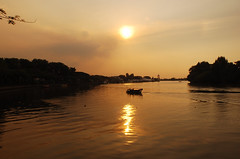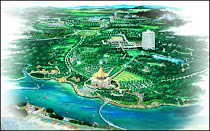THE MARKET-PLACE
The fresh food market is the first step in the distribution of foodstuffs from kitchen garden, from farm and plantation, from field and orchard, from river and sea. Leaving aside the supply chains to supermarket and processed food plant, the market appeals to that deep human wish to acquire raw food in as fresh a condition as possible. And nowhere is this more true than in the fish and seafood stalls the world over.
Most markets impress by their colours and the simplicity of their presentation. In fish markets, especially those on the quayside illuminated by the intense light off the sea, the brilliance of the hues and the boldness of pattern make for delicious visual preliminaries to the pleasures of cooking and consumption. Pinks and reds combine with silvers to gleam and glow with phosphorescence in the fresh rays of a coastal dawn - here, in Tangier. And all the colours of the ocean rainbow hang in a quayside fishmonger's in Valparaiso, Chile.
A market is a place of abundance and of richness of display: colours bright and fresh, whether arranged singly or in pyramids. Thank goodness, what is on sale varies from place to place, country to country, but we recognize the authentic market the world over by its evocation of 'plenty', by the display of tomatoes, peppers, courgettes and aubergines in any Mediterranean town, or by the towering arrangements of guavas, papayas, pineapples and breadfruit in the tropics. The breadfruit - proudly displayed by a Balinese chef (pic can be found from the book 'The Way We Live') - is native to the Pacific Islands. In 1793 it was introduced to Jamaica by Captain Bligh of Bounty fame in the belief that it could become the staple food of the slave population. The scheme was not a great success, but Jamaica does remain a major producer.
The imagery of the market-stall, whether a boat in Bangkok or a food counter in Burundi, is among the most potent in our appreciation of the good things of life and as close as many people get to the wider natural world. The imagery is rich in colour, texture, form and pattern, brought to life by the presence of people, often producers, in the processes of exchange. This is a world of buyers and sellers meeting with immediacy impossible in more rigidly formal environments (pic can be found from the book 'The Way We Live'). Sometimes the two parties come together in unplanned, spontaneous ways; this roadside market in Burundi developed as an almost impromptu happening (pic can be found from the book 'The Way We Live'). One man's meagre display is another's cornucopia; but however rich or spare the presentation, there is always the prospect - warm and reassuring - of acquisition and eventual consumption.
Whether a neighbourhood market in Paris, Rome or London or a village or country-town market in Morocco or Mauritius, the gathering together of people and produce is a real point of focus for a community, and any visitor. It is an opportunity for the exchange of views and gossip; and the feel-good fallout from the presence of so many good things is incalculable (pic can be found from the book 'The Way We Live'). Elizabeth David, surely the greatest English writer on food matters, found a unique joy in the sheer volume and variety on display in a good market: tomatoes, courgettes, peppers, melons, asparagus, strawberries, redcurrants, cherries, apricots, peaches, pears and plums. Her remarks were largely confined to descriptions of the markets of Provence and Italy, but her enthusiasm powerfully evoked the feelings aroused by food markets throughout the world.












No comments:
Post a Comment